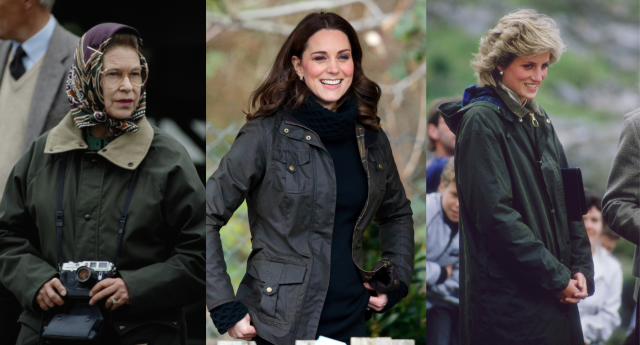Few garments epitomize British culture quite like the venerable Barbour jacket – an iconic olive-green, wax-coated all-weather essential beloved by none other than the Royal Family. It’s no surprise that UK Prime Minister Rishi Sunak presented a personalized version of this jacket to President Biden during their recent meeting. This gesture holds a dual symbolism: a representation of British identity and a reflection of the burgeoning camaraderie between the leaders. The jacket’s personal touch comes in the form of “Mr. President” embroidered on the front.
This gift is more than a gesture; it’s a powerful symbol. The prestigious, family-owned brand Barbour is situated near Prime Minister Sunak’s constituency in the Northeast of England, cementing its status as a quintessential British institution. Notably, Mr. Sunak himself is an ardent fan of the brand, frequently adorning Barbour attire. It’s worth noting that among the most iconic wearers of Barbour jackets, none have been as emblematic as the late Queen and the legendary US actor and motorcycle aficionado, Steve McQueen.
Beyond British Shores: Growing Appeal of the Barbour

In recent years, the Barbour jacket has transcended its British roots, making its mark across the Atlantic. A piece in The Spectator by a US author titled “How the Barbour cracked America” highlights its increasing popularity. The jacket has made appearances on TV screens, gracing episodes of series like “Succession,” often adorning the patriarch Logan Roy, as well as in “Industry” and most notably in “The Crown.”
Traditionally linked with the British upper classes, the Barbour jacket, akin to Land Rovers and Hunter wellington boots, embodies a sense of equestrian and hunting prestige. It holds a status akin to Burberry or Harris Tweed, symbolizing class, heritage, history, and superior craftsmanship. However, the journey of Barbour’s popularity has taken a nuanced route, expanding its appeal to a wider audience.
Roots in Rural Utility
Established in 1894 by Scotsman John Barbour in Newcastle’s South Shields, the brand initially focused on functional wear for countryside pursuits like hunting and fishing. The jackets were designed with gaming cartridge pockets, thornproof wax coating for traversing rugged terrain, and even featured a capacious “game pocket” capable of accommodating a full pheasant. Other variations were designed with shorter cuts to facilitate horseback riding.
With time, the jackets acquire a distinctive worn-in patina, endowing them with a charmingly disheveled character. The allure of a well-worn Barbour jacket is almost mythical, and the wax coating contributes to a recognizable earthy aroma.
In 1972, Dame Margaret Barbour assumed control of the family business, ushering in new styles. The golden era of the Barbour arrived with the emergence of soon-to-be Princess Diana in the public eye. Lady Diana Spencer’s influence in the late 1970s and early 80s popularized the jacket, and it became a quintessential choice for the “Sloane Ranger” look – a style parallel to the American preppy trend. The iconic “The Official Sloane Ranger Handbook” by Peter York and Ann Barr further solidified the identity. Diana’s portrayal in her Barbour jacket and pearls became synonymous with the Sloane Ranger image.
The Barbour Jacket, from Countryside to Festival Chic
As the Sloane Ranger aesthetic waned, the Barbour jacket experienced a resurgence, finding a new identity at the Glastonbury Festival – a bastion of British culture. It became the unofficial uniform for festivalgoers trudging through the mud, often paired with wellies and a mini dress. In 2013, style icon Alexa Chung collaborated with Barbour, infusing her distinct flair into the jackets. This partnership continues, with the latest collection drawing inspiration from Glastonbury in the 1990s. Chung’s sentiments captured the essence: “My fascination with blending practical and whimsical elements comes alive at music festivals.”
In 2020, Barbour transitioned from rural to urban, embracing streetwear in collaboration with Supreme, the skate label turned influential fashion force. This bold move proved successful, along with a surprising alliance with Scandi-chic brand Ganni. The Ganni X Barbour collection boasted a “re-loved” offering, featuring upcycled and reworked jackets.
A Legacy of Timelessness and Sustainability
The enduring appeal of Barbour jackets lies in their capacity for rejuvenation. The brand recently introduced the Wax for Life initiative, offering services to re-wax, repair, or customize existing Barbour jackets. These are jackets built to last, even gaining character with age. Eco-conscious figures like King Charles have donned their Barbour jackets for decades, while Queen Elizabeth refused a replacement for her well-worn jacket during her Jubilee.
Within the Barbour archives in Newcastle, decades-old jackets stand as testaments to their enduring design. Ian Bergin, the director of menswear, aptly described their appeal to Elle, “Their understated design makes them incredibly wearable. Their intrinsic purpose-driven design ensures they remain timeless, transcending fleeting trends.”
Barbour’s legacy is intertwining with quiet luxury, sustainined through generations as a family-owned endeavor. From rural charm to urban street cred, from the royal court to the festival grounds, the Barbour jacket has traversed diverse realms. It is the embodiment of a soft power gift, gently hinting at a myriad of qualities – history, functionality, sustainability, modernity, and more – while looking optimistically towards the future.
